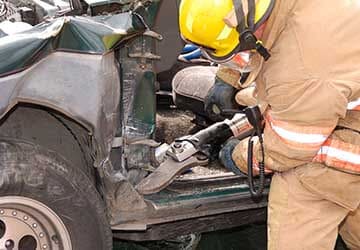SUV Accident Attorney in Brunswick, GA
SUVs are hefty vehicles with high centers of gravity. Often, SUVs have large blind spots due to their size, and drivers are unable to see people and other cars. The large vehicles often block the line of vision of other drivers and pedestrians. Their high center of gravity creates a significant risk of flipping over when swerving to avoid potential collisions.
 If you are injured by an SUV accident in Brunswick, give Strom Law Firm’s Brunswick SUV Accident Lawyers a call.
If you are injured by an SUV accident in Brunswick, give Strom Law Firm’s Brunswick SUV Accident Lawyers a call.
What Are The Different Types of SUVs?
SUV is an acronym, meaning “sport utility vehicle.” SUV is a very broadly used term, with no commonly agreed-upon definition. Definitions range from a requirement of off-road capabilities to a vehicle that is built on a truck chassis. While SUVs were very dangerous when they first arrived in the market, technological and design advances have added many safety features to make them safer for drivers.
There are three main categories of SUV:
- Full-size: Usually containing larger, high-horsepower engines, and lots of seats. Think of a Tahoe or a Suburban when you hear a full-size SUV. Full-size SUVs are more likely to roll over due to their size.
- Compact: These are the smallest SUVs. They sit lower to the ground and have higher fuel efficiency.
- Mid-size: Exactly as the name indicates. SUVs of this size fall between the sizes, fuel-efficiency, and power of full-size and compact.
The Perils of SUVs
The National Highway Traffic Safety Administration officially connected the dots in their 2015 report, determining that SUVs were deadlier for pedestrians than cars. Pedestrians struck by SUVs are twice or more as likely to die when struck by an SUV or a pick-up truck than when struck by an ordinary car.
The study explains that, while the majority of pedestrian fatalities are caused by light vehicles, a deeper look at the numbers shows that SUVs and Trucks are more likely to cause fatalities when striking pedestrians. While one-third of injuries to pedestrians are caused by SUVs and pick-ups, closer to 40 percent of pedestrian deaths are caused by such vehicles. The study further indicates that children and seniors are the most at risk for such fates.
Size matters when it comes to these statistics. The fact that SUVs sit higher off the ground means that, when striking a pedestrian, it is far more likely to strike the person’s vital organs and head. The front of SUVs tends to be flatter than cars, as well, which creates a much more blunt force when striking a pedestrian.
Additional perils of driving SUVs include:
- Top-heavy: The structure of SUVs makes them far more likely to roll over when sudden shifts in the movement are required.
- High clearance: As terrible as it sounds, the higher clearance of SUVs sometimes leads to a tragic and disturbing event. Cyclists and pedestrians can be pulled under the vehicle after being struck, and sometimes dragged along the road. Clearly, such an incident leads to severe injuries.
- Blind spots: The size and height of SUVs create more and larger blind spots. Sometimes, SUV drivers cannot see cars right next to them, let alone pedestrians, resulting in accidents.
- Higher horsepower and false security. These two factors are related because many drivers of SUVs feel too safe and have too much power. Their false sense of security leads them to drive their SUV at speeds that are unsafe, not only for pedestrians and other cars but for themselves. Teenagers are often the culprits of such behavior, but adults are known to drive this way too.
How Do You Avoid Accidents in SUVs?
The risks associated with SUVs will never be fully avoided, but through experience and technological upgrades, progress has been made in recent decades. Keep these tips in mind while driving an SUV or shopping for one:
- The later the model, usually the safer. Automakers have been forced to address the safety concerns of older SUVs by adding features that enhance safety. Such safety features include: backup cameras, parking assist, stabilizing technology, and the list goes on. Such features have helped make SUVs safer for drivers, passengers, and pedestrians alike. Even with all of these safety features, accidents still happen. Technological safety advances will continue to be made with every new model of SUV, but it is unlikely such advances will ever completely rid the world of SUV accidents. It is imperative upon the driver of each vehicle to operate the vehicle as safely as possible, and not use these safety features as a crutch.
- Drive an SUV like you understand the size and power of it. SUVs should not be driven like coupes and sedans. SUVs need to be operated with care. Sharp turns that might not be any problem for a low-riding car can cause an SUV to roll over, causing injuries.
- Practice extreme caution in keeping an eye out for other vehicles and pedestrians. Do not use the above-described safety features as a crutch. Use your own senses to keep an eye out for other cars and pedestrians. The size of an SUV can cause massive blind spots, leading to accidents with unseen cars and pedestrians. Be sure your rearview and side-view mirrors are positioned in a way that minimizes blind spots, and always check behind and beside you for any motorists or pedestrians.
- Keep your tires in good condition. A flat tire can cause your SUV to flip. Reduce this risk by ensuring that your tires are in good condition at all times. Replace your tires when necessary.
- Full-size and mid-size SUVs areheavy and take longer to stop. Do not tailgate the car in front of you. If that car is forced to slam on brakes, you will not be able to stop in time.
- Slow down. Again, do not drive your SUV like it’s a coupe or sedan. These vehicles were not intended to be race cars, and they are working vehicles that should be driven with caution. Speed kills, which is increasingly true when looking at SUV accidents. When possible, avoid sudden turns and swerves.
Why SUV Accidents Are Deadlier for Pedestrians
The NHTSA has proposed requiring automakers to equip certain vehicles with Electronic Stability Control (ESC) systems. According to the NHTSA, it “estimates ESC will reduce single-vehicle crashes of passenger cars by 34% and single-vehicle crashes of sport utility vehicles (SUVs) by 59%, with a much greater reduction of rollover crashes. NHTSA estimates ESC would save 5,300 to 9,600 lives and prevent 156,000 to 238,000 injuries in all types of crashes annually once all light vehicles on the road are equipped with ESC.”
Considering the number of lives saved and injuries avoided, it is an absolute no-brainer, even if not required by law, that manufacturers should include ESC on every car with a higher risk of overturning.
Contact A Brunswick SUV Accident Lawyer Today
If an SUV wreck or accident has injured you, you contact an attorney today to determine your chances of receiving compensation for your medical expenses and other damages. Our experienced Brunswick SUV Accident Lawyers will provide legal assistance. Our Brunswick SUV Accident Lawyers offer free evaluations & do not collect a fee unless we recover for you. Call Strom Law Firm today at 912.264.6465 or contact us online.

















